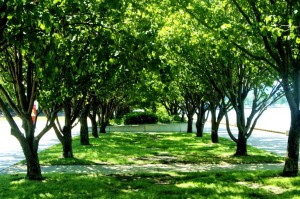When Identifying Trees, Balance Growth Rate With Hardiness
 When identifying trees for introducing shade into your yard, it’s tempting to head straight for a fast-growing variety, such as a silver maple. The trouble with these trees is that, while they may provide shade relatively soon, you may soon lose that shade to a spring thunderstorm or a windy day. Fast-growing trees don’t come with the hardiness you need to enjoy them year after year.
When identifying trees for introducing shade into your yard, it’s tempting to head straight for a fast-growing variety, such as a silver maple. The trouble with these trees is that, while they may provide shade relatively soon, you may soon lose that shade to a spring thunderstorm or a windy day. Fast-growing trees don’t come with the hardiness you need to enjoy them year after year.
It’s better to balance growth speed with hardiness when identifying trees that are best for your yard. First, it might be a good idea to shift your expectations to sitting in the shade of your tree in five to six years, with a growth pace of about two feet per year, maximum. Here are a few options:
Shade trees are deciduous and can grow to more than 50 feet, which is perfect for shading the average size yard. A northern red oak is a good choice for Zones 5-9, but it prefers moist, well-drained and acidic soil. Another option is the Freeman maple, which will treat you to a beautiful red-orange show in the fall. It’s ideal for Zones 4-7 and can grow to heights of 75 to 80 feet. It grows best in full sun and moist, well-drained soil.
The tulip tree is another tall beauty, rising to heights of 75 to 90 feet and spanning 40 to 50 feet wide. It thrives in Zones 5-9 and provides beautiful chartreuse tulip-shaped flowers in the spring, while turning yellow in the fall.
Screening trees can also be a nice way to define the boundaries of your yard, shield your backyard activities from view and offer protection from wind. Depending on the spread of the species you choose, you can plant them in groups, rows or alone.
Try the dawn redwood, particularly if you live in Zones 5-10. It grows in a pyramid shape and features deciduous green needles with a feathery feel. It can grow up to 100 feet tall, and up to 25 feet wide. Provide it with full sun, slightly acidic soil and it should grow well.
The European black adler is a great choice for bordering a pond or another wet area. It reaches a height of 40 to 60 feet and is generally 20 to 40 feet wide. It grows well in Zones 3-7 and provides wet soil, but full sun.
The green giant arborvitae is a classic screening tree that can grow up to three feet each year. It will reach a maximum height for 50 to 60 feet and will be 12 to 20 feet wide. It needs no shearing, but makes a nice hedge for a yard border.
Identifying trees for a shade yard often means sacrificing fast growth for the benefits of sturdier varieties. Be sure to identify your trees with Kincaid Plant Markers, so that as they grow, year after year, you’ll be able to give them individualized care. Take a look at our selection of plant markers, each made for a lifetime of gardening.
